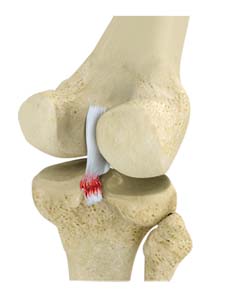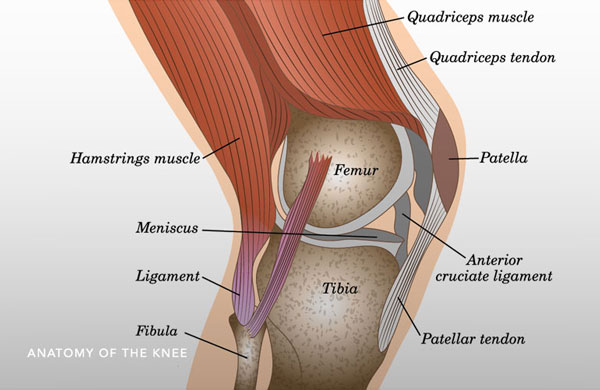
Knee anatomy
The knee is made of the femur (the thigh bone) and the tibia (the shin bone) which are connected by ligaments that hold the bones together and stabilize the knee.
There are two cruciate ligaments: The Anterior cruciate ligament (ACL) and the posterior cruciate ligament. (PCL) The PCL ligament is located behind the knee and controls the back and forth motion of the knee. The PCL is tougher than the ACL and so is less often injured.

The Posterior Cruciate Ligament (PCL) Injuries
PCL injuries make up less than 20% of knee ligament injuries. But, only 28% of PCL injuries occur alone. Most PCL injuries occur with other knee injuries including injury to the cartilage, other ligaments, bone, nerves and blood vessels. PCL injuries are common in football, soccer, baseball, and skiing.
PCL injuries are usually partial ligament tears, and typically heal on their own, without causing stability issues, so long as the knee is protected during healing, and there are no other knee joint injuries. However, PCL injuries can lead to osteoarthritis of the knee.
What causes PCL injuries?
The main cause is trauma, such as excessive force from an auto accident where the bent knee hits the dashboard, or a footballer player falls on a bent knee. It can also result from a sports injury like hyperextension and twisting. Knee dislocation usually involves a PCL injury. But, a PCL injury can also develop over time.
What are the symptoms?
There will be immediate knee pain and swelling, and a feeling of instability when standing or walking. The pain will be at the back of the knee and is worse kneeling. Pain in front of the knee may develop a week or two after the injury and will occur when attempting to speed up or slow down.
How is a PCL injury diagnosed?
PCL injuries are difficult to identify and evaluate because this ligament is located deep inside the knee joint and is often accompanied by injuries to other knee structures. So, a differential diagnosis is essential.
Dr. Stark will discuss with your symptoms and how the injury happened. He will conduct a physical examination and range of motion testing, but because PCL injuries are difficult to diagnose by physical exam alone, he will order imaging studies to rule out other knee injuries and confirm a diagnosis. He may recommend arthroscopy to view the tears and determine the extent of damage.
Nonsurgical treatment
While this injury may heal on its own, it can still be painful, and steps should be taken to protect the knee to prevent further injury. The initial injury should be treated with PRICE: Protection, rest, ice, compression and elevation, to support healing. Bracing and crutches may be recommended.
PCL ligament reconstruction
- You may need surgery if the PCL injury causes a piece of bone to be torn off when the ligament is torn
- Surgery may be recommended when the PCL injury is severe or is part of injury to other knee ligaments
- Surgery may also be recommended for athletes who suffer from chronically loose ligaments that cause symptoms
The procedure is designed to rebuild the ligament. Sewing the ends together does not usually heal a torn PCL ligament. Instead the torn ligament will be replaced with a tissue graft taken from another part of your body or from a donor.
Most often this surgery will be accomplished arthroscopically because it is the least invasive procedure. Recovery time will depend on the severity of the injury and can take 6-12 months for full recovery.
Whether you need surgery or not, rehabilitation is essential to getting you back to the life you love. Dr. Stark has office in Carlsbad.
Related Topics
- Anterior Cruciate Ligament (ACL) Tear/Reconstruction
- Knee Replacement (Partial and Total Knee Replacement)
- Collateral Ligament (MCL / LCL) Tear/Reconstruction
- Meniscus Tear/Repair
- Multi-Ligament Injuries
- Patellar/Knee Cap Instability
- Posterior Cruciate Ligament (PCL) Tear/Reconstruction
- Tendon Ruptures (Patella Quad Tendon Hamstring)
- Trochleoplasty
